|
Samurai Home & Character
|
Fujiyama Dojo P.O. Box 20003 Thorold, ON, Canada L2V 5B3 (905) 680-6389 |
|---|
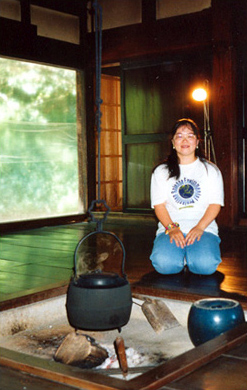 As a child I idolized Ryoma Sakamoto.
He was born into an obscure choningoshi (merchant-samurai) family from the Tosa domain and became one of the most notable men of his time, propelling Japan into the modern era. He was a visionary who kept his modesty, a man of revolutionary ideas who sought no power or recognition - a hero.
With that established, the reader will be able to imagine how I felt when our school organized a trip to Kochi prefecture to visit his birthplace, a trip which was to end at the foot of Ryoma's statue in Katsurahama.
Eventually, there we were, at the foot of the statue. I was fortunate enough to be in the front row, where I could look up to it. Until then, it had been one thrilling moment after another. But it came to pass that, as I stood there in awe, another student made her way to the front. She stood next to me, and after saying hello, uttered the words that I will never forget.
They went like this, "You know, he was a crybaby and a bed wetter as a child. As a man, he never bathed and he went around in these silly looking leather boots that smelled terrible. He was also very near-sighted."
I hope these words do not lose their cold innocent cruelty in the translation.
In truth, those words were not meant to be revelation or an insult. They were said with the same atonal indifference that one would use to read the ingredients on a cereal box, but to me, they evoked the unpleasant sound of nails scratching on a blackboard. The statue remained standing, but in my eyes the image was broken, never to be quite the same again.
Why the long preamble? Because it describes the effect that a "closer" look may have on an immature mind. Since it is my intention to venture, ever so slightly, into the house of the samurai, we might tarnish, unintentionally, the image of the bushi.
Kawabata Yasunari, Nobel Prize winner in Literature, said that one would "know more about a man by peeking into his home than you would by reading all he ever wrote." Of course he finished the phrase by adding, "But why would anyone want to do such a thing!"
Therefore, we will be cautious. As a child I idolized Ryoma Sakamoto.
He was born into an obscure choningoshi (merchant-samurai) family from the Tosa domain and became one of the most notable men of his time, propelling Japan into the modern era. He was a visionary who kept his modesty, a man of revolutionary ideas who sought no power or recognition - a hero.
With that established, the reader will be able to imagine how I felt when our school organized a trip to Kochi prefecture to visit his birthplace, a trip which was to end at the foot of Ryoma's statue in Katsurahama.
Eventually, there we were, at the foot of the statue. I was fortunate enough to be in the front row, where I could look up to it. Until then, it had been one thrilling moment after another. But it came to pass that, as I stood there in awe, another student made her way to the front. She stood next to me, and after saying hello, uttered the words that I will never forget.
They went like this, "You know, he was a crybaby and a bed wetter as a child. As a man, he never bathed and he went around in these silly looking leather boots that smelled terrible. He was also very near-sighted."
I hope these words do not lose their cold innocent cruelty in the translation.
In truth, those words were not meant to be revelation or an insult. They were said with the same atonal indifference that one would use to read the ingredients on a cereal box, but to me, they evoked the unpleasant sound of nails scratching on a blackboard. The statue remained standing, but in my eyes the image was broken, never to be quite the same again.
Why the long preamble? Because it describes the effect that a "closer" look may have on an immature mind. Since it is my intention to venture, ever so slightly, into the house of the samurai, we might tarnish, unintentionally, the image of the bushi.
Kawabata Yasunari, Nobel Prize winner in Literature, said that one would "know more about a man by peeking into his home than you would by reading all he ever wrote." Of course he finished the phrase by adding, "But why would anyone want to do such a thing!"
Therefore, we will be cautious.
The Front Gate
The House
Indoors
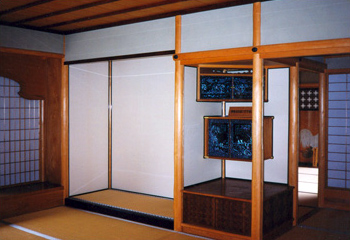 Returning to the honzashiki, we should add that it is in this room that poetry was read, where music was enjoyed, and most interaction took place. When samurai got together to indulge in poetry compositions, called renga, it was here that they sat. It is true that samurai did not gather to sip warm sake while engaging in animated conversation as often as we are led to believe by those yearly TV serials, but there were times of fellowship. Enough letters and narratives are available which make comments in appreciation of those infrequent times.
Friendship was not an alien concept for the samurai, we must add. Quite the contrary is true, but the environment in which these friendships developed makes them hard to understand for the contemporary mind. I realized that might be why, when a Japanese teacher tried to approach the subject while teaching in an American college, not one single student would agree that the traditional samurai actually kept friends. For those students, the fact that the samurai did not meet often, did not fraternize in some place of amusement every weekend, did not make their homes accessible, and so forth, meant that they did not actually practice friendship. The students could not understand why a man would sacrifice his life for another whom he saw only once every season (the teacher used the anecdote of Hosokawa Yusai's retainers at Tanabe castle siege). I will not try to succeed where a notable scholar failed, but I am very certain of one thing, that among the readers there will be some who are able to love and appreciate a friend, even if they can meet only four times a year.
Sometimes crossing historical and cultural borders is difficult. This same teacher we mentioned above spoke minutely and candidly to his class about the priest-poet Ikkyu, the warlords Takeda Shingen and Uesugi Kenshin, and female warrior Yamamoto Yaeko. To the teacher's despair, in spite of his efforts, all that the students drew from the lecture was that Ikkyu was a lech, Shingen a homosexual, Kenshin a fool, and Yaeko a "butch". Appalling as it may be, these labels obscured everything else that was said about those personalities.
When the teacher mentioned that Kenshin sent a letter to one of his opponents to settle the time of a battle, or described how the warlord gave fair advantages to his opponents, the students took these actions as pure nonsense. Even when Hojo Ujiyasu's comments about Kenshin were read ("Kenshin is the only man who, once he agrees to do something for you, carries out his obligation no matter what happens to himself"), the prevalent opinion did not change, and the character of the warlord was ridiculed. I must add that I have heard very similar comments from Japanese youth.
Another example of such difficulty was the visit of a foreign teacher to Japan a few years ago. Filled with enthusiasm, he visited the areas where the founder of his ryu lived and began making inquiries about the man and his times. Fortunately or not, he was put in contact with people who knew the real story, not the glamorized version of popular novels. Through them, he learned that the founder was a soft-spoken man, not a vociferous leader; that he could not tolerate much alcohol so, most of the time, he only pretended to drink; that he preferred reading to hunting; that he despised formal attire (i.e. kamishimo)... and the list of troublesome information went on. But he had other blows coming to him. He learned that true samurai seldom touched money; that the vast majority of them were terrible with finances, and as a rule, the wives were in charge of the household administration; that women had more say and participation in spite of their demure image than most history books are willing to concede; that true samurai viewed it as shameful to call attention to themselves and abhorred flamboyance; and so on... For a man who enjoyed drinking, money, popularity, dressing up, being the centre of attention and appreciated women mostly for their physical attributes, this knowledge was as painful as an impacted tooth. Still, upon his return, this teacher made no mention of these facts, and kept on promoting the image which best suited him, and he continues to emulate it with gusto, even though it more closely resembles a character from a chambara movie than the ryu's founder. A harmless and funny thing, I guess, but revealing nevertheless.
The honzashiki is also the area where the samurai spent time with his children. We have found that family life is viewed from a distance in some textbooks, and rarely is any credit given to the samurai as a father. I have been rather moved to read poems dedicated to his children by samurai. Many of them were dedicated to daughters. And in a number of letters, I was pleased to discover the concern of samurai away from home for all his children, including those whose mother was a concubine.
One of my favorite readings was a letter written by a minor retainer of Lord Sanada Yukimura, who, on a trip to Kyoto, had the opportunity to visit a theatre. He did so, taking great measures not to be noticed. Although the letter was written to his wife, this particular section was obviously addressed to his children, and it is written in such a way as one would tell about an exciting but naughty adventure. I do not know whether the letter was delivered, since the exhibit where I saw it did not explain it, but if any of us received one like it today, it would not evoke the image of a distant father in any way. Actually, nor that of a distant husband, for that matter, since it candidly expresses his longing for his wife's companionship and favors, and swears to it "as one kneeling on white sand", and although the reference is a bit obscure today, it must mean deep sincerity. Does not such a letter destroy the stereotype of the stoic, detached, and emotionless samurai? If one had read poems written by samurai in praise of a particular season, a landscape, even a single flower, one could hardly envision the samurai as emotionless. How can one reconcile lack of emotion with the personality of the samurai when one learns about a samurai who stops his entourage on a country road of his own domain, to offer his own mino (a type of straw cape) to an old lady to protect her from the rain? Since this lady is from the lower caste (non-person), this gesture is all the more notable.
Another anecdote describes how a samurai fended off a group of samurai youth (among which was his own son), who were tormenting a crippled and deformed boy, also from the lowest caste. When the samurai's own son protested, alleging that the boy was a non-person, the irate and ashamed father struck him and rebuked him, saying that he had not understood at all what it means to be a samurai.
When crops failed for lack of rain, typhoons, or other reasons, and farmers could not cover their taxes, some daimyos reduced them, or did not demand them at all, and when their reserves permitted, gave rice from their own storehouses to those in need.
We have to agree that such examples might not depict a majority, but what we can affirm is that those who acted in such a way, not only did not lack the right kind of emotions, but conducted themselves according to the proper manner of the true samurai. They obviously understood what Kaibara Ekken meant by saying that man's benevolence was not "[just] being able to deliver a fatal cut with the sword so well as to be painless, but handing a bowl of rice to a beggar." Returning to the honzashiki, we should add that it is in this room that poetry was read, where music was enjoyed, and most interaction took place. When samurai got together to indulge in poetry compositions, called renga, it was here that they sat. It is true that samurai did not gather to sip warm sake while engaging in animated conversation as often as we are led to believe by those yearly TV serials, but there were times of fellowship. Enough letters and narratives are available which make comments in appreciation of those infrequent times.
Friendship was not an alien concept for the samurai, we must add. Quite the contrary is true, but the environment in which these friendships developed makes them hard to understand for the contemporary mind. I realized that might be why, when a Japanese teacher tried to approach the subject while teaching in an American college, not one single student would agree that the traditional samurai actually kept friends. For those students, the fact that the samurai did not meet often, did not fraternize in some place of amusement every weekend, did not make their homes accessible, and so forth, meant that they did not actually practice friendship. The students could not understand why a man would sacrifice his life for another whom he saw only once every season (the teacher used the anecdote of Hosokawa Yusai's retainers at Tanabe castle siege). I will not try to succeed where a notable scholar failed, but I am very certain of one thing, that among the readers there will be some who are able to love and appreciate a friend, even if they can meet only four times a year.
Sometimes crossing historical and cultural borders is difficult. This same teacher we mentioned above spoke minutely and candidly to his class about the priest-poet Ikkyu, the warlords Takeda Shingen and Uesugi Kenshin, and female warrior Yamamoto Yaeko. To the teacher's despair, in spite of his efforts, all that the students drew from the lecture was that Ikkyu was a lech, Shingen a homosexual, Kenshin a fool, and Yaeko a "butch". Appalling as it may be, these labels obscured everything else that was said about those personalities.
When the teacher mentioned that Kenshin sent a letter to one of his opponents to settle the time of a battle, or described how the warlord gave fair advantages to his opponents, the students took these actions as pure nonsense. Even when Hojo Ujiyasu's comments about Kenshin were read ("Kenshin is the only man who, once he agrees to do something for you, carries out his obligation no matter what happens to himself"), the prevalent opinion did not change, and the character of the warlord was ridiculed. I must add that I have heard very similar comments from Japanese youth.
Another example of such difficulty was the visit of a foreign teacher to Japan a few years ago. Filled with enthusiasm, he visited the areas where the founder of his ryu lived and began making inquiries about the man and his times. Fortunately or not, he was put in contact with people who knew the real story, not the glamorized version of popular novels. Through them, he learned that the founder was a soft-spoken man, not a vociferous leader; that he could not tolerate much alcohol so, most of the time, he only pretended to drink; that he preferred reading to hunting; that he despised formal attire (i.e. kamishimo)... and the list of troublesome information went on. But he had other blows coming to him. He learned that true samurai seldom touched money; that the vast majority of them were terrible with finances, and as a rule, the wives were in charge of the household administration; that women had more say and participation in spite of their demure image than most history books are willing to concede; that true samurai viewed it as shameful to call attention to themselves and abhorred flamboyance; and so on... For a man who enjoyed drinking, money, popularity, dressing up, being the centre of attention and appreciated women mostly for their physical attributes, this knowledge was as painful as an impacted tooth. Still, upon his return, this teacher made no mention of these facts, and kept on promoting the image which best suited him, and he continues to emulate it with gusto, even though it more closely resembles a character from a chambara movie than the ryu's founder. A harmless and funny thing, I guess, but revealing nevertheless.
The honzashiki is also the area where the samurai spent time with his children. We have found that family life is viewed from a distance in some textbooks, and rarely is any credit given to the samurai as a father. I have been rather moved to read poems dedicated to his children by samurai. Many of them were dedicated to daughters. And in a number of letters, I was pleased to discover the concern of samurai away from home for all his children, including those whose mother was a concubine.
One of my favorite readings was a letter written by a minor retainer of Lord Sanada Yukimura, who, on a trip to Kyoto, had the opportunity to visit a theatre. He did so, taking great measures not to be noticed. Although the letter was written to his wife, this particular section was obviously addressed to his children, and it is written in such a way as one would tell about an exciting but naughty adventure. I do not know whether the letter was delivered, since the exhibit where I saw it did not explain it, but if any of us received one like it today, it would not evoke the image of a distant father in any way. Actually, nor that of a distant husband, for that matter, since it candidly expresses his longing for his wife's companionship and favors, and swears to it "as one kneeling on white sand", and although the reference is a bit obscure today, it must mean deep sincerity. Does not such a letter destroy the stereotype of the stoic, detached, and emotionless samurai? If one had read poems written by samurai in praise of a particular season, a landscape, even a single flower, one could hardly envision the samurai as emotionless. How can one reconcile lack of emotion with the personality of the samurai when one learns about a samurai who stops his entourage on a country road of his own domain, to offer his own mino (a type of straw cape) to an old lady to protect her from the rain? Since this lady is from the lower caste (non-person), this gesture is all the more notable.
Another anecdote describes how a samurai fended off a group of samurai youth (among which was his own son), who were tormenting a crippled and deformed boy, also from the lowest caste. When the samurai's own son protested, alleging that the boy was a non-person, the irate and ashamed father struck him and rebuked him, saying that he had not understood at all what it means to be a samurai.
When crops failed for lack of rain, typhoons, or other reasons, and farmers could not cover their taxes, some daimyos reduced them, or did not demand them at all, and when their reserves permitted, gave rice from their own storehouses to those in need.
We have to agree that such examples might not depict a majority, but what we can affirm is that those who acted in such a way, not only did not lack the right kind of emotions, but conducted themselves according to the proper manner of the true samurai. They obviously understood what Kaibara Ekken meant by saying that man's benevolence was not "[just] being able to deliver a fatal cut with the sword so well as to be painless, but handing a bowl of rice to a beggar."
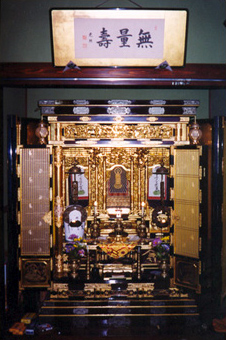 Another important area of the house was the heya, or oie, which can be described as private rooms. These rooms, whose floors were always covered with tatami, served as alcoves for the house's owner, but also as places of work. These are the rooms used for writing, reading, the practice of calligraphy, for meditation, or simply for moments of tranquility. In many instances they also doubled as sleeping quarters. These rooms were the inner sanctum of the house, and certainly not a place of frequent traffic. In spite of their privacy, the decor was carefully done, since the reason for it was not to show it off, but to create the proper atmosphere for the mind (spirit) to find harmony.
In the household of those who practiced the Buddhist faith, we would find a small separated room called butsuma. This room housed the Butsuden, or Buddhist altar, on which the mortuary tablets of ancestors would be placed. Households who followed the Shinto religion would also have a shrine, called kamidana, but it was not as often located in a separate room.
The last room we will visit will be the kitchen, or daidokoro. The daidokoro had a hearth used for cooking, which was often larger than the one located in the honzashiki. It was a relatively spacious room divided into two sections. One was outfitted with a wooden floor, where the dinners would be served, and a second lower level (tanamoto no niwa, nagashi) with a floor of hardened earth, where the actual food preparation took place. It is in the daidokoro that the house's formal back door was located.
Sometimes the umaya, or stables, were connected to the house, sometimes there were separate buildings.
To offer a complete description of a samurai home, one would have to include descriptions of pathways, inner and outer gardens, tea houses, even spear rooms, for all those things and more were included in some of them. I have chosen to explore an average home, to be able to talk more about the above-average man. It was not our intention to produce an essay on architecture or design, nor about samurai ethics. So much as been said, and so much has been written that deprive the samurai of his individual voice. As I said at the beginning, this is a candid look to offer a personal view, much closer, and a tad more humane, I hope, than some of the articles I have read in the last few years. Another important area of the house was the heya, or oie, which can be described as private rooms. These rooms, whose floors were always covered with tatami, served as alcoves for the house's owner, but also as places of work. These are the rooms used for writing, reading, the practice of calligraphy, for meditation, or simply for moments of tranquility. In many instances they also doubled as sleeping quarters. These rooms were the inner sanctum of the house, and certainly not a place of frequent traffic. In spite of their privacy, the decor was carefully done, since the reason for it was not to show it off, but to create the proper atmosphere for the mind (spirit) to find harmony.
In the household of those who practiced the Buddhist faith, we would find a small separated room called butsuma. This room housed the Butsuden, or Buddhist altar, on which the mortuary tablets of ancestors would be placed. Households who followed the Shinto religion would also have a shrine, called kamidana, but it was not as often located in a separate room.
The last room we will visit will be the kitchen, or daidokoro. The daidokoro had a hearth used for cooking, which was often larger than the one located in the honzashiki. It was a relatively spacious room divided into two sections. One was outfitted with a wooden floor, where the dinners would be served, and a second lower level (tanamoto no niwa, nagashi) with a floor of hardened earth, where the actual food preparation took place. It is in the daidokoro that the house's formal back door was located.
Sometimes the umaya, or stables, were connected to the house, sometimes there were separate buildings.
To offer a complete description of a samurai home, one would have to include descriptions of pathways, inner and outer gardens, tea houses, even spear rooms, for all those things and more were included in some of them. I have chosen to explore an average home, to be able to talk more about the above-average man. It was not our intention to produce an essay on architecture or design, nor about samurai ethics. So much as been said, and so much has been written that deprive the samurai of his individual voice. As I said at the beginning, this is a candid look to offer a personal view, much closer, and a tad more humane, I hope, than some of the articles I have read in the last few years.
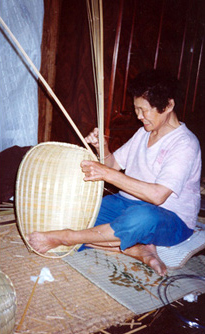 Not long ago, I went to visit a distant relative of mine who lives very far away, and away from everything. How old she is, she would not confess, but suffice to say that she has seen many generations come and go, and her dyed hair cannot hide the memories. Listening to her is like reading a very old and fascinating book. And it is with her that I spoke about how times have changed, about how little was left of the old traditions, that only the dry and increasingly incomprehensible crust of our customs and identity seems to remain, muddled by a long series of old and new imports. She was weaving bamboo baskets at the time, sitting in her workshop. She makes no money doing it, nor does she have any need of it. Still, she rises every day at sun-up, to cut the strips of bamboo and weave one basket after another.
As usual, she smiled and after shrugging, replied, "Things always change. But I do not think that all is gone, or that all is bad. I make my baskets in the same way that they have always been made, but I just add a little piece of wire, and they last longer. So, for me, nothing has really changed. "How about for you?" I know she did not expect an answer, so I remained silent while she continued weaving her basket, as they have always been woven.
I walk among hundreds of high school boys and girls waiting at the train station, holding on to their cell-phones as if they were their life force intake valve, I realize how far we have come since the era of the samurai, and wonder how much we have learned, or improved. Regardless, it is not up to me to judge, but deep down, as I go by, I cannot help but keep a warm and safe place in my heart for that little old lady weaving history, past and present, with a smile, with just a little piece of wire. Not long ago, I went to visit a distant relative of mine who lives very far away, and away from everything. How old she is, she would not confess, but suffice to say that she has seen many generations come and go, and her dyed hair cannot hide the memories. Listening to her is like reading a very old and fascinating book. And it is with her that I spoke about how times have changed, about how little was left of the old traditions, that only the dry and increasingly incomprehensible crust of our customs and identity seems to remain, muddled by a long series of old and new imports. She was weaving bamboo baskets at the time, sitting in her workshop. She makes no money doing it, nor does she have any need of it. Still, she rises every day at sun-up, to cut the strips of bamboo and weave one basket after another.
As usual, she smiled and after shrugging, replied, "Things always change. But I do not think that all is gone, or that all is bad. I make my baskets in the same way that they have always been made, but I just add a little piece of wire, and they last longer. So, for me, nothing has really changed. "How about for you?" I know she did not expect an answer, so I remained silent while she continued weaving her basket, as they have always been woven.
I walk among hundreds of high school boys and girls waiting at the train station, holding on to their cell-phones as if they were their life force intake valve, I realize how far we have come since the era of the samurai, and wonder how much we have learned, or improved. Regardless, it is not up to me to judge, but deep down, as I go by, I cannot help but keep a warm and safe place in my heart for that little old lady weaving history, past and present, with a smile, with just a little piece of wire.
|
|---|


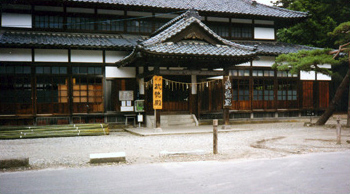 The front entrance to the house of a samurai of not too high rank was not unlike that of a merchant's, but one notable difference is the omotemon, or front gate. To build a front gate, a sort of threshold onto the samurai's property, required a permit, and only sword-bearing families were granted this permit. These gates were closely linked with the rules of etiquette, because it was before crossing this gate that the visitor would make his presence known, often by loudly saying "Gomen" or "Gomen kudasare!"
The front entrance to the house of a samurai of not too high rank was not unlike that of a merchant's, but one notable difference is the omotemon, or front gate. To build a front gate, a sort of threshold onto the samurai's property, required a permit, and only sword-bearing families were granted this permit. These gates were closely linked with the rules of etiquette, because it was before crossing this gate that the visitor would make his presence known, often by loudly saying "Gomen" or "Gomen kudasare!"
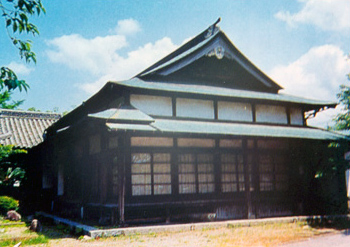 Ceramic tiles were sometimes used to construct the roof. They lasted longer and were less vulnerable to fire, of course, but they were also much more expensive than the thatched roofs we find more frequently in the houses of goshi (rural samurai), as well as in farm houses, and even country inns, etc.
Ceramic tiles were sometimes used to construct the roof. They lasted longer and were less vulnerable to fire, of course, but they were also much more expensive than the thatched roofs we find more frequently in the houses of goshi (rural samurai), as well as in farm houses, and even country inns, etc.
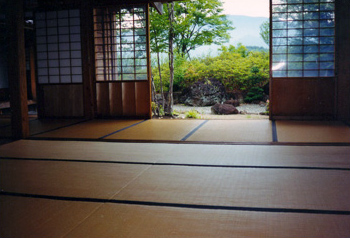 As we enter the house, we would probably find ourselves in the shikidai. This room could have a wooden floor, or hardened earth, but normally it was a combination of both. It probably had bare walls, and a sliding door would separate it from the honzashiki, which could be described as a living room, or receiving room of sorts.
As we enter the house, we would probably find ourselves in the shikidai. This room could have a wooden floor, or hardened earth, but normally it was a combination of both. It probably had bare walls, and a sliding door would separate it from the honzashiki, which could be described as a living room, or receiving room of sorts.
